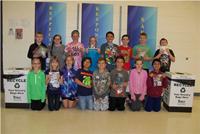Classroom Presentations Fulfill Illinois State Standards

Many of the Illinois State Standards are addressed in the classroom presentations provided by Will County. Just a partial list of these standards is listed below:
12. B.1a. Describe and compare characteristics of living things in relationship to their environments.
12. B.2a. Describe relationships among various organisms in their environments (e.g., predator/prey, parasite/host, food chains and food webs).
12. B.4a. Compare physical, ecological and behavioral factors that influence interactions and interdependence of organisms.
12. B. 1b. Describe how living things depend on one another for survival.
12. B. 2b. Identify physical features of plant and animals that help them live in different environments (e.g., specialized teeth for eating certain foods, thorns for protection, insulation for cold temperature).
12. C. 1a. Identify and compare sources of energy (e.g., batteries, the sun).
12. E. 2a. Identify and explain natural cycles of the Earth’s land, water and atmospheric systems (e.g., rock cycle, water cycle, weather patterns).
12E. 3a. Analyze and explain large-scale dynamic forces, events and processes that affect the Earth’s land, water and atmospheric systems (e.g. jet stream, hurricanes, plate tectonics).
12E. 1c. Identify renewable and nonrenewable natural resources.
12E. 2c. Identify and classify recyclable materials.
12E. 3c. Evaluate the biodegradability of renewable and nonrenewable natural resources.
13. B. 2d. Compare the relative effectiveness of reducing, reusing and recycling in actual situations.
13B. 1e. Demonstrate ways to reduce, reuse, and recycle materials.
13B. 2e. Identify and explain ways that technology changes ecosystems (e.g., dams, highways, buildings, communication networks, power plants).
13B. 3e. Identify advantages and disadvantages of natural resource conservation and management programs.
13B. 2f. Analyze how specific personal and societal choices that humans make affect local, regional, and global ecosystems (e.g., lawn and garden care, mass transit).
13B. 3f. Apply classroom-developed criteria to determine the effects of policies on local science and technology issues (e.g., energy consumption, landfills, water quality).
2-LS2-1. Plant depend on water and light.
4-ESS3-1. Energy from natural resources.
5-PS3-1. Energy from the Sun-Food.
5-LS1-1. Plants get their needs from air and water.
5-ESS3-1. Human impact on earth, conservation & resources.
MS- LS1-4. Food webs & flow of energy in an ecosystem.
MS-ESS3-3. Human impact on the environment.
MS-ESS3-4. Human consumption of natural resources.
HS-ESS3-2. Wise energy use & recycling, renewable resources.
HS-ESS3-3. Human impacts, sustainability, natural resources.
State Law 95-0741 titled Solid Waste-School Recycling
Requires each school district to periodically review its procurement procedures and specifications related to the purchase of products and supplies and modify them as necessary to require the school district to seek out products and supplies that contain recycled materials and to ensure that purchased products and supplies are reusable, durable, or made from recycled materials, if economically and practically feasible. Provides that in selecting products and supplies that contain recycled material, preference must be given to products and supplies that contain the highest amount of recycled material and that are consistent with the effective use of the product or supply, if economically and practically feasible. Makes changes concerning the procurement of recycled paper and paper products and minimum levels. Each school district shall periodically review its procedures on solid waste reduction regarding the management of solid waste generated by academic, administrative, and other institutional functions. Sets forth procedure requirements.
©2010 Will County EEC. All Rights Reserved | Web site design and development by Americaneagle.com
|